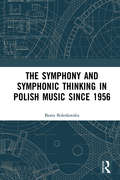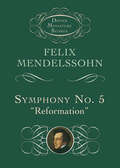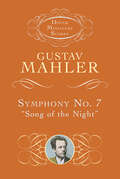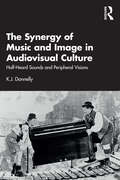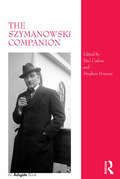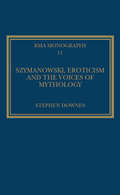- Table View
- List View
The Symphony and Symphonic Thinking in Polish Music Since 1956
by Beata Bolesławska1956 was a year of transition in Poland, and an important year for Polish music. This year saw the beginning of a political thaw – sometimes called the Polish October – in communist Poland. It was also the year of the establishment of the 'Warsaw Autumn' International Festival of Contemporary Music. This was a time of great artistic ferment in Polish music, which also deeply influenced symphonic thinking. The year 1956 is thus an appropriate starting point for Beata Bolesławska’s study of the contemporary Polish symphonic tradition. Bolesławska investigates the influential Polish avant-garde, illuminating the ways in which new musical means and ideas influenced symphonic music and the genre of the symphony in the music of such important composers as Witold Lutosławski (1913–1994), Henryk Mikołaj Górecki (1933–2010) and Krzysztof Penderecki (b. 1933). Referring to the main elements of the European tradition, as well as examining briefly the symphonic activity in Poland before 1956, the book concentrates on the symphonic writing in the context of avant-garde trends, represented by the so-called 'Polish school of composers', as well as on its later redefinitions proposed by Polish composers up to the present day.
The Symphony in Australia, 1960-2020
by Rhoderick McNeillThe Symphony remained a major orchestral form in Australia between 1960 and 2020, with a body of diverse and interesting symphonies produced during the 1960s and 70s that defied the widespread modernist trends of serialism, electronic music and indeterminism that seemed harbingers of the symphony’s demise. From the late 1970s onwards, many Australian composers chose to work in styles that admitted modal and tonal melodic and harmonic elements with regular pulse. Major cycles of symphonies by Carl Vine, Brenton Broadstock and Ross Edwards began to appear in the late 1980s. Other prolific symphonists like Paul Paviour (10 symphonies), David Morgan (15 symphonies), Philip Bracanin (9), Peter Tahourdin (5), John Polglase (5) and many others demonstrated a revived interest in the form. This trend continued into the first two decades of the present century with symphonies by Matthew Hindson, Katy Abbott, Stuart Greenbaum, Andrew Schultz, Mark Isaacs and Gordon Kerry. This renewed interest in the symphony reflects similar trends in Britain and the United States. Rhoderick McNeil provides a comprehensive introduction to this large body of music with the aim of making the music and its composers known to concert-goers, music educators and students, conductors and music entrepreneurs.
The Symphony in Australia, 1960-2020
by Rhoderick McNeillThe Symphony remained a major orchestral form in Australia between 1960 and 2020, with a body of diverse and interesting symphonies produced during the 1960s and 70s that defied the widespread modernist trends of serialism, electronic music and indeterminism that seemed harbingers of the symphony’s demise. From the late 1970s onwards, many Australian composers chose to work in styles that admitted modal and tonal melodic and harmonic elements with regular pulse. Major cycles of symphonies by Carl Vine, Brenton Broadstock and Ross Edwards began to appear in the late 1980s. Other prolific symphonists like Paul Paviour (10 symphonies), David Morgan (15 symphonies), Philip Bracanin (9), Peter Tahourdin (5), John Polglase (5) and many others demonstrated a revived interest in the form. This trend continued into the first two decades of the present century with symphonies by Matthew Hindson, Katy Abbott, Stuart Greenbaum, Andrew Schultz, Mark Isaacs and Gordon Kerry. This renewed interest in the symphony reflects similar trends in Britain and the United States. Rhoderick McNeil provides a comprehensive introduction to this large body of music with the aim of making the music and its composers known to concert-goers, music educators and students, conductors and music entrepreneurs.
Symphony No 104: second movement (three part arrangement) (PDF)
by Saz HaydnThis is a musical score in Modified Stave Notation. The original file is available as .mscz format and the braille music version as .brf from mas@rnib.org.uk
Symphony No 104: First movement, three part arrangement (PDF)
by Saz HaydnThis is a musical score in Modified Stave Notation. The original file is available as .mscz format and the braille music version as .brf from mas@rnib.org.uk
Symphony No. 104: Third movement (three part arrangement) (PDF)
by Saz HaydnThis is a musical score in Modified Stave Notation. The original file is available as .mscz format and the braille music version as .brf from mas@rnib.org.uk
Symphony No. 104: fourth movement (three part arrangement) (PDF)
by Saz HaydnThis is a musical score in Modified Stave Notation. The original file is available as .mscz format and the braille music version as .brf from mas@rnib.org.uk
Symphony No. 4 (Italian): First movement (three part arrangement) (PDF)
by Mendelssohn SazThis is a musical score in Modified Stave Notation. The original file is available as .mscz format and the braille music version as .brf from mas@rnib.org.uk
Symphony No. 4 (Italian): second movement (three part arrangement) (PDF)
by Mendelssohn SazThis is a musical score in Modified Stave Notation. The original file is available as .mscz format and the braille music version as .brf from mas@rnib.org.uk
Symphony No.4 (Italian): third movement (three part arrangement) (PDF)
by Mendelssohn SazThis is a musical score in Modified Stave Notation. The original file is available as .mscz format and the braille music version as .brf from mas@rnib.org.uk
Symphony No. 4 (Italian): Fourth movement (three part arrangement) (PDF)
by Mendelssohn SazThis is a musical score in Modified Stave Notation. The original file is available as .mscz format and the braille music version as .brf from mas@rnib.org.uk
Symphony No. 5: "Reformation"
by Felix MendelssohnIn this staple of the orchestral repertoire, Mendelssohn interprets the Reformation in symphonic terms, building to a powerful series of variations on Martin Luther's confessional chorale, Ein feste Burg ist unser Gott (A Mighty Fortress Is Our God). This miniature score is reproduced from an authoritative edition, complete with numbered movements for easy reference. Affordable and compact, it is ideal for use in the classroom, at home, or in the concert hall.
Symphony No. 7: "Song of the Night"
by Gustav MahlerMahler's seventh symphony ranks among the composer's most popular and accessible works. Possessing neither a "program" nor a folk-song theme, it is a purely instrumental composition, both hopeful and romantic in mood, with a harmonic and stylistic structure that evokes the daily journey from dusk till dawn. This miniature score is reproduced from an authoritative edition, complete with numbered movements for easy reference. Affordable and compact, it is ideal for use in the classroom, at home, or in the concert hall.
Sync or Swarm, Revised Edition: Improvising Music in a Complex Age
by David BorgoThe revised edition of Sync or Swarm promotes an ecological view of musicking, moving us from a subject-centered to a system-centered view of improvisation. It explores cycles of organismic self-regulation, cycles of sensorimotor coupling between organism and environment, and cycles of intersubjective interaction mediated via socio-technological networks. Chapters funnel outward, from the solo improviser (Evan Parker), to nonlinear group dynamics (Sam Rivers trio), to networks that comprise improvisational communities, to pedagogical dynamics that affect how individuals learn, completing the hermeneutic circle. Winner of the Society for Ethnomusicology's Alan Merriam prize in its first edition, the revised edition features new sections that highlight electro-acoustic and transcultural improvisation, and concomitant issues of human-machine interaction and postcolonial studies.
Sync or Swarm, Revised Edition: Improvising Music in a Complex Age
by David BorgoThe revised edition of Sync or Swarm promotes an ecological view of musicking, moving us from a subject-centered to a system-centered view of improvisation. It explores cycles of organismic self-regulation, cycles of sensorimotor coupling between organism and environment, and cycles of intersubjective interaction mediated via socio-technological networks. Chapters funnel outward, from the solo improviser (Evan Parker), to nonlinear group dynamics (Sam Rivers trio), to networks that comprise improvisational communities, to pedagogical dynamics that affect how individuals learn, completing the hermeneutic circle. Winner of the Society for Ethnomusicology's Alan Merriam prize in its first edition, the revised edition features new sections that highlight electro-acoustic and transcultural improvisation, and concomitant issues of human-machine interaction and postcolonial studies.
The Synergy of Music and Image in Audiovisual Culture: Half-Heard Sounds and Peripheral Visions
by K.J. DonnellyThe Synergy of Music and Image in Audiovisual Culture: Half-Heard Sounds and Peripheral Visions asks what it means to understand music as part of an audiovisual whole, rather than separate components of music and film. Bringing together revised and updated essays on music in a variety of media – including film, television, and video games – this book explores the importance of partially perceived and registered auditory and visual elements and cultural context in creating unique audiovisual experiences. Critiquing traditional models of the film score, The Synergy of Music and Image in Audiovisual Culture enables readers across music, film, and cultural studies to approach and think about audiovisual culture in new ways.
The Synergy of Music and Image in Audiovisual Culture: Half-Heard Sounds and Peripheral Visions
by K.J. DonnellyThe Synergy of Music and Image in Audiovisual Culture: Half-Heard Sounds and Peripheral Visions asks what it means to understand music as part of an audiovisual whole, rather than separate components of music and film. Bringing together revised and updated essays on music in a variety of media – including film, television, and video games – this book explores the importance of partially perceived and registered auditory and visual elements and cultural context in creating unique audiovisual experiences. Critiquing traditional models of the film score, The Synergy of Music and Image in Audiovisual Culture enables readers across music, film, and cultural studies to approach and think about audiovisual culture in new ways.
Syntagma Musicum III (Early Music Series)
by Michael PraetoriusMichael Praetorius (1571-1621) was one of the most versatile, wide-ranging, and prolific German composers of the seventeenth century. Also important as a theorist, his Syntagma Musicum, penned around 1619, was originally planned in four parts. He completed only three, with the first discussing the place of music in the church, while Volume II focused on musical instruments. Volume III deals with terminology, theoretical issues, and performance practice. More than any other source from this period, Volume III provides the most thorough coverage of performance practice issues of the late sixteenth and early seventeenth centuries. It offers detailed commentary about the performance of particular pieces of music, including many of Praetorius's own, as well as those by Lassus, Gabrieli, Monteverdi, and Schütz. Throughout, Praetorius offers immensely practical insights on numerous topics such as the definition and classification of vocal forms, the names and characteristics of instruments, arrangement of large-scale works for multiple choirs, description of ligatures, use of proportions, time signatures, transposition, teaching the Italian manner of singing, the types of ornamentation used in Italy in the first two decades of the seventeenth century-and much more. Praetorius is the most often quoted and excerpted writer on performance practice. In this translation, musicologist and early music practitioner Jeffery T. Kite-Powell worked with notoriously difficult syntax to produce a definitive English edition of this important work. For modern scholars, this volume is the preeminent source of contemporary information on performance practice for the late Renaissance and early Baroque periods. This essential resource will enable performers to recreate the music of the period in a historically informed manner.
The Synthesizer: A Comprehensive Guide to Understanding, Programming, Playing, and Recording the Ultimate Electronic Music Instrument
by Mark VailElectronic music instruments weren't called synthesizers until the 1950s, but their lineage began in 1919 with Russian inventor Lev Sergeyevich Termen's development of the Etherphone, now known as the Theremin. From that point, synthesizers have undergone a remarkable evolution from prohibitively large mid-century models confined to university laboratories to the development of musical synthesis software that runs on tablet computers and portable media devices. Throughout its history, the synthesizer has always been at the forefront of technology for the arts. In The Synthesizer: A Comprehensive Guide to Understanding, Programming, Playing, and Recording the Ultimate Electronic Music Instrument, veteran music technology journalist, educator, and performer Mark Vail tells the complete story of the synthesizer: the origins of the many forms the instrument takes; crucial advancements in sound generation, musical control, and composition made with instruments that may have become best sellers or gone entirely unnoticed; and the basics and intricacies of acoustics and synthesized sound. Vail also describes how to successfully select, program, and play a synthesizer; what alternative controllers exist for creating electronic music; and how to stay focused and productive when faced with a room full of instruments. This one-stop reference guide on all things synthesizer also offers tips on encouraging creativity, layering sounds, performance, composing and recording for film and television, and much more.
The Synthesizer: A Comprehensive Guide to Understanding, Programming, Playing, and Recording the Ultimate Electronic Music Instrument
by Mark VailElectronic music instruments weren't called synthesizers until the 1950s, but their lineage began in 1919 with Russian inventor Lev Sergeyevich Termen's development of the Etherphone, now known as the Theremin. From that point, synthesizers have undergone a remarkable evolution from prohibitively large mid-century models confined to university laboratories to the development of musical synthesis software that runs on tablet computers and portable media devices. Throughout its history, the synthesizer has always been at the forefront of technology for the arts. In The Synthesizer: A Comprehensive Guide to Understanding, Programming, Playing, and Recording the Ultimate Electronic Music Instrument, veteran music technology journalist, educator, and performer Mark Vail tells the complete story of the synthesizer: the origins of the many forms the instrument takes; crucial advancements in sound generation, musical control, and composition made with instruments that may have become best sellers or gone entirely unnoticed; and the basics and intricacies of acoustics and synthesized sound. Vail also describes how to successfully select, program, and play a synthesizer; what alternative controllers exist for creating electronic music; and how to stay focused and productive when faced with a room full of instruments. This one-stop reference guide on all things synthesizer also offers tips on encouraging creativity, layering sounds, performance, composing and recording for film and television, and much more.
Syrene Soundes: False Relations in the English Renaissance
by Eleanor ChanFalse relations remain one of the great enigmas of English Renaissance musical culture. Contemporary theoretical treatises explicitly discouraged their use, and yet these deliberate dissonances are hallmarks of English Renaissance music. Over the centuries they have accumulated a surfeit of subsequent connotations that have obscured how they once functioned, yet they have never been fully critically explored or elucidated in an English context. In Syrene Soundes, author Eleanor Chan excavates beneath strata of accumulated meanings to uncover the way that false relations delighted and confounded their original listeners and performers. The book offers a holistic investigation of the false relations phenomenon, examining the cultural, literary, visual, and material understanding of such dissonances in relation to the broader culture of incongruity, surprise and error, and metaphors of harmony that captured the imagination of the English in the sixteenth and seventeenth centuries. Chan argues that interdisciplinary angles can galvanise understanding of technical musical theoretical tropes like the false relation. She demonstrates that the false relation and its graphic ephemerality can productively be explored through the lens of English Renaissance visual culture and its idiosyncratic representational strategies. By anchoring it within the milieu of the English Reformation, burgeoning aspirations towards empire, and the increasing need for a self-fashioned collective English identity, Chan reveals that the false relation was key to the mythology of an inherited English tradition of music-making. Syrene Soundes concerns itself not just with the notes on the page, but with the way that they influenced the broader culture of the time, both as the performable music they represented, as the idea of music, and as the visual, inky marks they are made of. It provides an accessible introduction to false relations which will be of use to musicologists and non-music specialists alike. Ultimately, Chan argues for the value of integrated interdisciplinary analysis in exploring the musical culture of the English Renaissance and embraces the blurring of musical, visual, material, and literary forms of expression that fed contemporary understanding of music, harmony, and falseness.
Syrene Soundes: False Relations in the English Renaissance
by Eleanor ChanFalse relations remain one of the great enigmas of English Renaissance musical culture. Contemporary theoretical treatises explicitly discouraged their use, and yet these deliberate dissonances are hallmarks of English Renaissance music. Over the centuries they have accumulated a surfeit of subsequent connotations that have obscured how they once functioned, yet they have never been fully critically explored or elucidated in an English context. In Syrene Soundes, author Eleanor Chan excavates beneath strata of accumulated meanings to uncover the way that false relations delighted and confounded their original listeners and performers. The book offers a holistic investigation of the false relations phenomenon, examining the cultural, literary, visual, and material understanding of such dissonances in relation to the broader culture of incongruity, surprise and error, and metaphors of harmony that captured the imagination of the English in the sixteenth and seventeenth centuries. Chan argues that interdisciplinary angles can galvanise understanding of technical musical theoretical tropes like the false relation. She demonstrates that the false relation and its graphic ephemerality can productively be explored through the lens of English Renaissance visual culture and its idiosyncratic representational strategies. By anchoring it within the milieu of the English Reformation, burgeoning aspirations towards empire, and the increasing need for a self-fashioned collective English identity, Chan reveals that the false relation was key to the mythology of an inherited English tradition of music-making. Syrene Soundes concerns itself not just with the notes on the page, but with the way that they influenced the broader culture of the time, both as the performable music they represented, as the idea of music, and as the visual, inky marks they are made of. It provides an accessible introduction to false relations which will be of use to musicologists and non-music specialists alike. Ultimately, Chan argues for the value of integrated interdisciplinary analysis in exploring the musical culture of the English Renaissance and embraces the blurring of musical, visual, material, and literary forms of expression that fed contemporary understanding of music, harmony, and falseness.
The Szymanowski Companion
by Stephen DownesThe Polish composer Karol Szymanowski is one of the most fascinating musical figures of the early twentieth century. His works included four symphonies, two violin concertos, the operas Hagith and King Roger, the ballet-pantomime Harnasie, the oratorio Stabat Mater, as well as numerous piano, violin, vocal and choral compositions. The profile and popularity of Szymanowski's music outside Poland has never been higher and continues to grow. The Szymanowski Companion constitutes the most significant and comprehensive reference source to the composer in English. Edited by two of the leading scholars in the field, Paul Cadrin and Stephen Downes, the collection consists of over 50 contributions from an international array of contributors, including recognized Polish experts. The Companion thus provides a systematic, authoritative and up-to-date compilation of information concerning the composer's life, thought and works.
The Szymanowski Companion
by Stephen DownesThe Polish composer Karol Szymanowski is one of the most fascinating musical figures of the early twentieth century. His works included four symphonies, two violin concertos, the operas Hagith and King Roger, the ballet-pantomime Harnasie, the oratorio Stabat Mater, as well as numerous piano, violin, vocal and choral compositions. The profile and popularity of Szymanowski's music outside Poland has never been higher and continues to grow. The Szymanowski Companion constitutes the most significant and comprehensive reference source to the composer in English. Edited by two of the leading scholars in the field, Paul Cadrin and Stephen Downes, the collection consists of over 50 contributions from an international array of contributors, including recognized Polish experts. The Companion thus provides a systematic, authoritative and up-to-date compilation of information concerning the composer's life, thought and works.
Szymanowski, Eroticism and the Voices of Mythology
by Stephen DownesThe desire to voice the artistic revelation of the truth of a precarious, multi-faceted, yet integrated self lies behind much of Szymanowski's work. This self is projected through the voices of deities who speak languages of love. The unifying figure is Eros, who may be embodied as Dionysus, Christ, Narcissus or Orpheus, and the gospel he proclaims tells of the resurrection and freedom of the desiring subject. This book examines Szymanowski's exploration of the relationship between the authorial voice, mythology and eroticism within the context of the crisis of the modern subject in Western culture. Stephen Downes analyses mythological and erotic aspects of selected songs from the composer's early career, moving to an interpretation of the voice of the homoerotic lover, embodied as a mad muezzin, in terms of heroic notions of Orphic elegy. Discussing the encounters of King Roger with the voices of Narcissus, the Siren and Dionysus, Downes shows how the composer uses the unifying Christ/Eros figure as a means of indicating that the King might be transformed from anguished despot to loving expressive subject. The book ends with an examination of Szymanowski's desire to fuse Slavonic and Middle-Eastern mythological inspirations in an attempt to fulfil a utopian vision of a pan-European culture bound together by the spirit of Eros.
